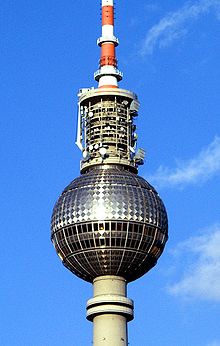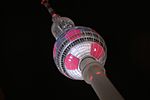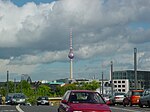Fernsehturm Berlin: Difference between revisions
| Line 28: | Line 28: | ||
==History== |
==History== |
||
In 1964, [[Walter Ulbricht]], leader of the [[Socialist Unity Party of Germany|Socialist Unity Party]] which governed East Germany, decided to allow the construction of a television tower on the Alexanderplatz. The Berliner Fernsehturm was modelled on the [[Fernsehturm Stuttgart]]. The architecture traces back to an idea from [[Hermann Henselmann]] and |
In 1964, [[Walter Ulbricht]], leader of the [[Socialist Unity Party of Germany|Socialist Unity Party]] which governed East Germany, decided to allow the construction of a television tower on the Alexanderplatz. The Berliner Fernsehturm was modelled on the [[Fernsehturm Stuttgart]]. The architecture traces back to an idea from [[Hermann Henselmann]], and Jörg Streitparth. Walter Herzong and Herbert Aust later also took part in the planning. Construction began on [[4 August]] [[1965]]. After four years of construction, the Fernsehturm began test broadcasts on [[3 October]] [[1969]], and it was officially inaugurated four days later on the GDR's National Day. It is among the best known sights in Berlin, and has around a million visitors every year. It has been likened to a stalk of [[asparagus]]. ([[East Berlin]] journalists sometimes referred to it as the ''Telespargel'', "tele-asparagus", and recently by [[blog]]gers to the ''[[Death Star]]'' from [[Star Wars]].){{Fact|reason=please cite the source|date=May 2009}}. |
||
Construction of the tower had initially begun at a site in southeast Berlin's Müggelberg. |
Construction of the tower had initially begun at a site in southeast Berlin's Müggelberg. However, the project was stopped because such a tall tower in that location would have obstructed aircraft entering and leaving from the nearby [[Schönefeld International Airport]]{{Fact|reason=please provide a document|date=May 2009}}. |
||
==The "Pope's Revenge"== |
==The "Pope's Revenge"== |
||
Revision as of 20:13, 12 June 2009
| Berliner Fernsehturm | |
|---|---|
 The Fernsehturm from south with in foreground the Marienkirche and the Hotel Park Inn | |
 | |
| General information | |
| Type | Television tower, Restaurant, Observation tower |
| Location | Berlin (Germany) |
| Coordinates | 52°31′15″N 13°24′34″E / 52.52083°N 13.40944°E |
| Completed | 3 October 1969 |
| Height | 368.03 m (1,207.45 ft) |
| Design and construction | |
| Architect(s) | |
| Main contractor | |

The Fernsehturm (German for "television tower") is a television tower in the city centre of Berlin, Germany. This well-known landmark, close to Alexanderplatz and part of the World Federation of Great Towers (WFGT), was constructed between 1965 and 1969 by the former German Democratic Republic (GDR). The GDR administration intended it as a symbol of Berlin, which it remains today,[1] as it is easily visible throughout the central and some suburban districts of Berlin.
Overview

The original total height of the tower was 365 metres (1198 feet), but it rose to 368 m (1207 ft) after the installation of a new antenna in the 1990s. The Fernsehturm is the fourth tallest freestanding structure in Europe, after Moscow's Ostankino Tower, the Kiev TV Tower and the Riga Radio and TV Tower. There is a visitor platform and a rotating restaurant in the middle of the sphere. The visitor platform is at a height of about 204 m (669 ft) above the ground and visibility can reach 42 km (26 miles) on a clear day. The restaurant, which rotates once every 30 minutes[2], is a few metres above the visitors platform (originally it turned once per hour; the speed was later doubled following the tower's late 1990s renovation).
Inside the shaft are two lifts that shuttle visitors up to the sphere of the tower within 40 seconds. It is not accessible by wheelchair.
To mark the 2006 FIFA World Cup in Germany, for which the final match was played in the Berlin Olympic Stadium, the sphere was decorated as a football with magenta-coloured pentagons, reflecting the corporate colour of World Cup sponsor and owner of the Fernsehturm, Deutsche Telekom. Owing to its suggestive shape, the tower is sometimes referred to as "Telespargel" (TV asparagus), although this nickname is virtually never used by Berliners themselves.
History
In 1964, Walter Ulbricht, leader of the Socialist Unity Party which governed East Germany, decided to allow the construction of a television tower on the Alexanderplatz. The Berliner Fernsehturm was modelled on the Fernsehturm Stuttgart. The architecture traces back to an idea from Hermann Henselmann, and Jörg Streitparth. Walter Herzong and Herbert Aust later also took part in the planning. Construction began on 4 August 1965. After four years of construction, the Fernsehturm began test broadcasts on 3 October 1969, and it was officially inaugurated four days later on the GDR's National Day. It is among the best known sights in Berlin, and has around a million visitors every year. It has been likened to a stalk of asparagus. (East Berlin journalists sometimes referred to it as the Telespargel, "tele-asparagus", and recently by bloggers to the Death Star from Star Wars.)[citation needed].
Construction of the tower had initially begun at a site in southeast Berlin's Müggelberg. However, the project was stopped because such a tall tower in that location would have obstructed aircraft entering and leaving from the nearby Schönefeld International Airport[citation needed].
The "Pope's Revenge"


When the sun shines on the Fernsehturm's tiled stainless steel dome, the reflection usually appears in the form of a cross. This effect was neither predicted nor desired by the planners. As a jibe against the atheist foundations of the Communist government, and the ongoing suppression of church institutions in East Germany, Berliners immediately named the luminous cross Rache des Papstes, or "Pope's Revenge". For the same reasons, the structure was also called "St. Walter" (from Walter Ulbricht).
U.S. President Ronald Reagan mentioned this phenomenon in his "Tear down this wall" speech on 12 June 1987:
Years ago, before the East Germans began rebuilding their churches, they erected a secular structure: the television tower at Alexanderplatz. Virtually ever since, the authorities have been working to correct what they view as the tower's one major flaw: treating the glass sphere at the top with paints and chemicals of every kind. Yet even today when the sun strikes that sphere, that sphere that towers over all Berlin, the light makes the sign of the cross. There in Berlin, like the city itself, symbols of love, symbols of worship, cannot be suppressed.
Technical details
- 1 Tuned mass damper
- Entrance of observation deck is 6.25 metres (20.5 ft) above ground
- 2 Kone lifts for transport of visitors
- 1 lift for transport of technical equipment
- Steel stairway with 986 steps
- Evacuation platforms at 188 metres (594 ft) and 191 metres (627 ft) high
- Observation deck at 203.78 metres (669 ft)
- Restaurant at 207.53 metres (681 ft)
- Height of the tower: 368.03 metres (1207 ft)
- Weight of the shaft: 26,000 tonnes
- Weight of the sphere 4,800 tonnes
Channels by frequency
Analogue FM radio
- 87.9 MHz - Star FM
- 90.2 MHz - BBC World Service
- 91.4 MHz - Berliner Rundfunk
- 93.6 MHz - Jam FM
- 94.3 MHz - rs2
- 95.8 MHz - RBB Radio Eins
- 97.7 MHz - Deutschlandfunk
- 98.8 MHz - Kiss FM
- 99.7 MHz - Antenne Brandenburg
- 100.6 MHz - Motor FM
- 101.3 MHz - Klassik Radio
- 101.9 MHz - JazzRadio 101.9
- 102.6 MHz - RBB Fritz
- 103.4 MHz - Energy Berlin
- 104.6 MHz - 104.6 RTL
- 105.5 MHz - Spreeradio
- 106 MHz - Radio France Internationale
- Block 12B - 225.648 MHz (DAB)
- FIRST Audio iDLS
- Rock Antenne
- Block 12D - 229.072 MHz (DAB)
- Block LA - 1452.960 MHz
- All Digital One stations (DAB)
- Channel 4 (DMB)
- E4 (DMB)
- ITN (DMB)
- ITV1 (DMB)
Digital television (DVB-T)
- VHF 5 (177.5 MHz) - Mixed Berlin 1
- VHF 7 (191.5 MHz) - ARD regional programming
- UHF 25 (506 MHz) - RTL Group
- UHF 27 (522 MHz) - ARD national programming
- Das Erste
- rbb Fernsehen Berlin
- Phoenix
- EinsExtra/rbb Fernsehen Brandenburg
- UHF 33 (570 MHz) - ZDF
- UHF 44 (658 MHz) - ProSiebenSat.1
- UHF 56 (754 MHz) - Mixed Berlin 2
- UHF 59 (778 MHz) - Mixed Berlin 3
Image gallery
-
The Fernsehturm sphere decorated as a football in the runup to the World Cup 2006.
-
Fernsehturm with roof of pavilion
-
View from inside the Fernsehturm, 2007
-
View from foot of the tower.
-
View of the Berlin Fernsehturm during 2007 Festival of Lights.
-
View from the Berlin Fernsehturm in January 2008
-
The Fernsehturm.
-
Close up of the Fernsehturm.
-
Painters are painting the Fernsehturm as a football.
-
Fernsehturm behind the Berliner Dom.
-
Fernsehturm at night.
-
Fernsehturm seen in distance.
References
- ^ "Berliner Fernsehturm - History". berlinerfernsehturm.de. Retrieved 2008-12-09.
- ^ http://www.berlinerfernsehturm.de/en/erlebnis_en.asp?site=erlebnis&usite=erlebnis
See also
- World Federation of Great Towers
- List of towers
- List of tallest freestanding structures in the world
- Fernsehturm Stuttgart
- Funkturm Berlin
- Fernmeldeturm Berlin
External links
- Berlin Television Tower at Structurae
- Fernsehturm Official Website
- Berlin Television Tower panoramic views day + night - Berlin virtual city
- 360°Panorama Fernsehtum during the Festival of Lights
- Berliner Fernsehturm during Football Worldcup 06
- All about the tower and Panorama
- Travel Video about Berlin Television Tower
Template:Supertall observation and communication towers 52°31′15″N 13°24′34″E / 52.52083°N 13.40944°E{{#coordinates:}}: cannot have more than one primary tag per page











